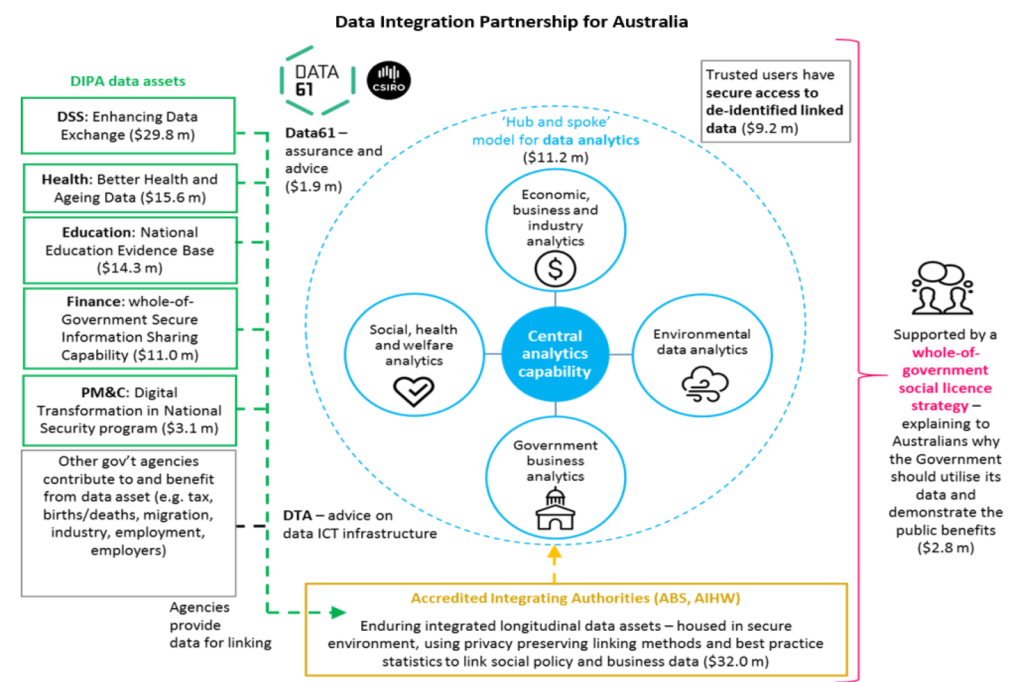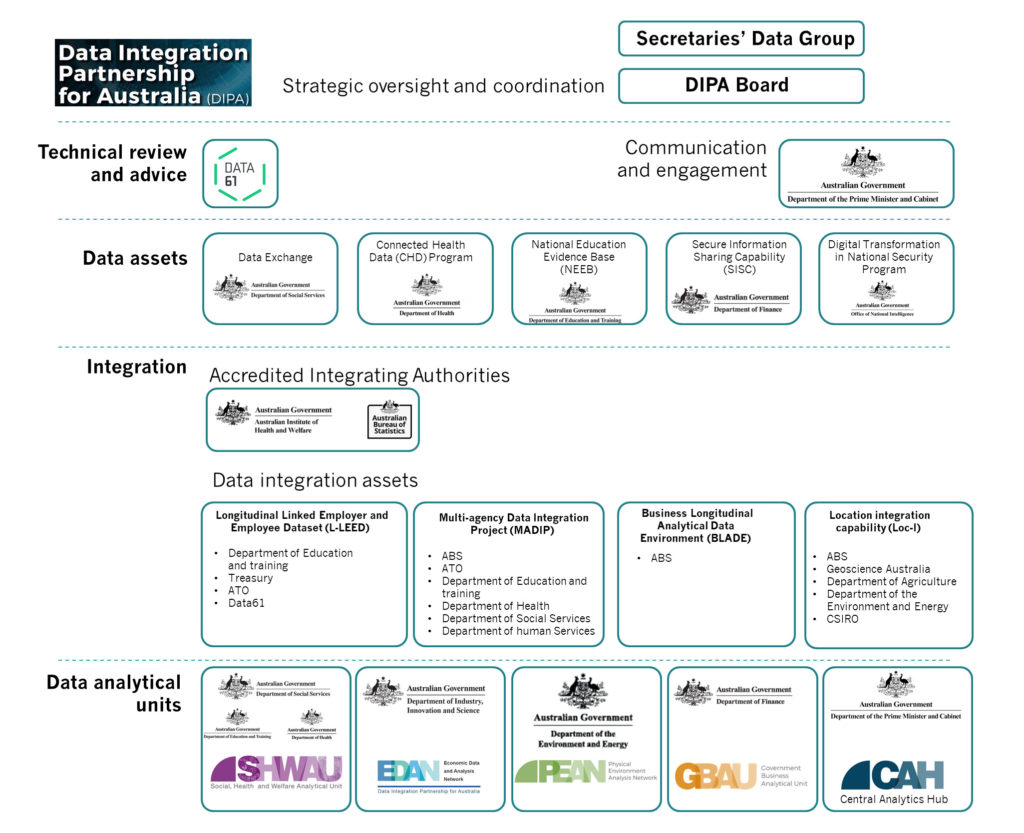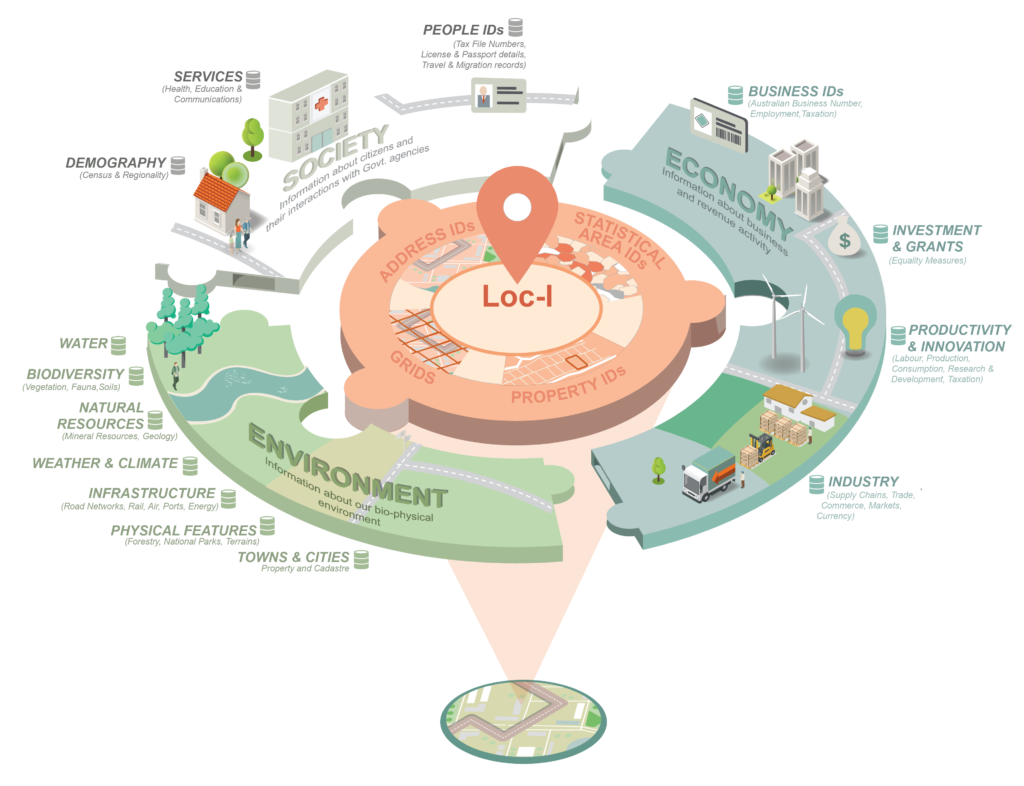Data Integration Partnership for Australia (DIPA)
The challenges facing society are complex, embedded, and systemic. Data and understanding that data can help us understand what actions to take and align diverse groups of people. This is acknowledged by the Australian government and there is a structured approach to aligning data from multiple agencies across all aspects of society.
The Data Integration Partnership for Australia
The Data Integration Partnership for Australia program is Australia’s strategic and focused approach to data. The cross-agency initiative started in 2017 and involves over 20 government agencies in the three-year, $130.8 million program to “maximise the use and value of the Government’s data assets.”
I previously shared about the current Federal review of innovation indicators, the global OECD Entrepreneurship indicators program, and the Innovation and Science Australia’s\2016 review of the national innovation system. In addition to those reviews, the DIPA program is establishing more robust and reliable data sources for improved policy development and industry and government decision making. Other documents related to the program include recommendations in the 2016 Public Sector Data Management Implementation report and observations in the 2015 Department of the Prime Minister and Cabinet’s submission to the Productivity Commission’s Inquiry into Data Availability and Use.
I am making my way through considering how nations approach data and information related to innovation and entrepreneur support. These posts act as a personal daily reference point as I aim to simplify what can seem complex on initial glance. It can help to document concepts in succinct daily post for public consumption. If others find value through the process, all the better.
DIPA program details
The scope and scale of the DIPA program is significant. The structure includes: governance, administration, and technical input; creation of data assets; development of data integration assets; and data analytical units to utilise the data. The program provides a graphic to explain the program, included below.

I came across another diagram developed as part of a presentation by Strategic Policy & Data Analytics, which adds in budgets for each of the components:

The process of creating diagrams can help make sense of the program and who is involved. I developed the one below to walk through the different aspects of the program:

1. Governance and administration
The DIPA project sits under the Secretaries’ Data Group, and is governed by a DIPA Board. Data 61 which is the data arm government research entity CSIRO provides technical review and advice, and the Department of Premier and Cabinet manages communication and engagement.
2. Data assets
The program is building or supporting a series of data assets from different areas of health, education, finance, social services, and intelligence. Some assets appear to have been already in development, others were created as part of the project, and some there is little information apart from the initial announcement.
Health
The Connected Health Data (CHD) Program with the Department of health aims to:
- Build a safe and secure platform for managing data access through Health’s existing Enterprise Data Warehouse (EDW)
- Expand and enhance health and aged care data to unlock the value of this information
- Make health and aged care data assets available more widely within government for policy development, program evaluation and research
Social services
The Department of Social Service’s Data Exchange was released in 2014 and was “developed to improve the way we collect and use administrative data to improve the wellbeing of people and families in our communities.”
Education
The Department of Education’s $14.3 million National Education Evidence Base (NEEB) program commenced in 2017 and is designed to “draw together data on all aspects of education— early childhood education and care, schools, vocational education and training and higher education to be a resource available to staff to provide easy access to the data and analysis needed to inform policy and decision making.” The program is in response to the increasing costs of education in Australia without corresponding improvements in education, as outlined in the 2018 Productivity Commission Inquiry Report.
Finance
There is little online about the Finance Department’s Secure Information Sharing Capability (SISC) program, apart from a 2017 news reference.
Intelligence
The Digital Transformation in National Security Program was intended to investigate modernising and transformative benefits across the national security community. Similar to the SISC, there is little reference to the current program apart from the initial announcement.
3. Data integration
Two organisations are funded to act as Accredited Integrating Authorities to “ensure integrated data is de-identified, confidentialised and analysed in safe, secure and controlled environments.” These are the Australian Institute of Health and Welfare (AIHW) and the Australian Bureau of Statistics (ABS).
Four integration platforms are included in the initial DIPA program:
i. Multi-agency Data Integration Project (MADIP)
The Multi-agency Data Integration Project (MADIP) is “a partnership among Australian Government agencies to develop a secure and enduring approach for combining information on healthcare, education, government payments, personal income tax, and population demographics (including the Census) to create a comprehensive picture of Australia over time.”
ii. Business Longitudinal Analytical Data Environment (BLADE)
The Business Longitudinal Analytical Data Environment (BLADE) combines business tax data and information from ABS surveys over time to provide a better understanding of Australian businesses and the economy.
BLADE and MADIP Projects
Examples of projects are listed for both BLADE and MADIP. The platforms share projects in many instances and there is a reasonable view that the integration platforms could be combined in the future.
The projects touch on all aspects of society and examine many of the complex issues that can be informed by data, including indigenous health, complex economic company structures, suicide rates, water use, innovation impact, and much more. An example specific to my personal focus area of entrepreneurship and innovation, Sasan Bakhtiari release two papers outlining Entrepreneurship Dynamics in Australia: Lessons from Micro-data in 2017 and 2019.
A more in depth review to map these projects will be valuable, but perhaps in a future post.
iii. Longitudinal Linked Employer and Employee Dataset (L-LEED)
From a 2015 blog on data.gov.au, a linked employer and employee dataset is designed to:
- Integrate person and business administrative data sourced from the ATO.
- Be linked longitudinally, as well as provide point in time data.
- Build on the Expanded Analytical Business Longitudinal Database, which integrates business tax and survey data.
Justification for a LEED was demonstrated in a 2015 ABS research paper and is an ongoing project with the ABS to “simultaneous analysis of met supply and demand in the Australian labour market.”
- A LEED can provide supplementary labour statistics and facilitate labour market research. A LEED can help us study micro-labour markets; examine how specific events (such as a natural disaster) impact employees and employers; and understand structural changes in the labour market.
- A LEED associates information about a person with information about their employing business. This is done by establishing the existence of a job. An employed person can have one or more jobs, and a job can be created by the personal enterprise of the individual (e.g. an owner manager).
A visual description of the LEED structure from the ABS is below:
iv. Location Index (Loc-I)
The Location index commenced in 2018 and provides “a framework that provides a consistent way to seamlessly integrate data on people, business, and the environment. Location Index aims to extend the characteristics of the foundation spatial data of taking geospatial data (multiple geographies) which is essential to support public safety and wellbeing, or critical for a national or government decision making that contributes significantly to economic, social and environmental sustainability and linking it with observational data. Through providing the infrastructure to support cross-domain foundation data linkages and analysis will open up substantial opportunity for providing a richer set of information to develop, analyse and evaluate policy, programs and service delivery by government. “

4. Data Analytical units
The DIPA then supports five data analytical units to leverage the data integration platforms for specific aspects of society: Whole of government policy, Social welfare, Physical, Economy, and Government business data.
Central Analytics Hub

The Central Analytics Hub is focused on policy, with an aim to “use integrated data to generate insights about complex policy questions in areas of government priority. These include projects focusing on whole-of-government priority policy issues, informing taskforces, policy development and other government processes.”
Examples of projects include exploring the gender pay gap and the national drought map.
Economic Data and Analysis Network (EDAN)

The Economic Data and Analysis Network (EDAN) is focused on economic impact and “is generating new insights into the operation of the economy and evaluating the performance of policies, programs and services that impact on business.”
The project sits in the Department of Industry, Innovation, and Science and produced the previously mentioned papers on Entrepreneurship Dynamics in Australia: Lessons from Micro-data in 2017 and 2019.
Government Business Analytical Unit (GBAU)

The Government Business Analytical Unit (GBAU) focuses on government data, “creating efficiencies and reduce duplication in collecting, creating and analysing government business data.”
Headed up by the Department of Finance in 2018, the platform was credited in the Department’s 2018-2019 budget report as growing the Department’s “capability and increased the use of data to inform public sector policy and government administration. New data analytics expertise and investment in technology is enabling Finance to use data, including from across the APS, in a more sophisticated way to build an evidence base, inform policy-making, and enhance reporting and transparency including through analysis of APS Employee Census data.”
Plans for 2019-2020 include:
- Commonwealth land analysis ($160,000)
- Maintaining information on Commonwealth entities and companies as a searchable data asset ($70,000)
- Measuring the effectiveness of additional administrative process in productivity and procurement outcomes ($225,000)
- Entity-level mapping of government expenditure to functions ($220,000)
Physical Environment Analysis Network

The Physical Environment Analysis Network program focuses data relating to the physical environment to “enable faster and more comprehensive responses to current policy issues, such as building community resilience to natural disasters, links between urban environmental quality and heath and the effects of changing energy prices on businesses and regional communities.”
Established in 2017, the program has working on projects relating to the Northern Territory, Water and society, Natural disasters, Energy, and Gas. Current projects include:
- Reducing life lost from heatwaves ($465,000)
- Indigenous environmental programs: socio-economic analysis ($380,000)
- Industrial energy productivity: to what extent is there a gap between frontier and laggard firms? ($150,000)
- Effects of drought on Australian farms ($300,00)
Social, Health and Welfare Analytical Unit

The Social, Health and Welfare Analytical Unit ” leverages combined data analytics efforts across the education, health and welfare sectors to gain insights to inform more effective, targeted and earlier policy interventions, service and program delivery that impact, often directly, on Australian’s lives.”
Current projects include;
- The first five years: What makes a difference? ($371,405)
- Exits from Income Support ($473,556)
- Intergenerational welfare dependence ($195,762)
- Healthy Mind, Healthy Body: Identifying opportunities to prevent the cascading physical health and social impacts of poor mental health ($344,905)
- Harnessing Academic Expertise for High Impact Commonwealth Government Analytics ($280,000)
So what and what’s next
The DIPA program is relatively recent and many advances are within the past five years. It is encouraging to see advances as data is opened up to external researchers to access the collective wisdom of a nation of researchers, policy makers, and entrepreneurs who can leverage the data for the benefit of society.
Looking to the future, I expect we will continue to move towards standardisation and centralisation of common data pools that are accessible, accurate, and timely. This will have significant impact on decision making as we move past debates of popular opinion and vested interest.
The DOIPA framework provide a platform. the tools are in place. It will be exciting to see the outcomes as we leverage the tools for the collective benefit of society.
